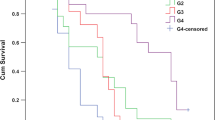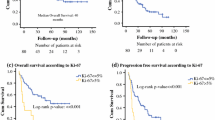Abstract
Gender influence on survival in mesothelioma has been observed in several large clinical series. However, this gender effect has not been investigated. Female patients often have less aggressive tumors and survive longer. However, few studies in the literature have explained the molecular basis of this finding. Understanding this difference at a molecular level may offer the hope of improving survival via hormonal manipulation.We investigate the expression of Ki-67 and sex steroid receptors; estrogen receptors (ER), progesterone receptors (PR) and androgen receptors (AR) to elucidate any pathognomonic difference that characterize this gender difference. Positive expression of markers was observed in 95% (Ki-67), 80% (ER), 100% (PR) and 65% (AR) of patients. Expression of markers between gender showed a higher Ki-67 in males (M = 1.3%, F = 0.6%), higher estrogen receptor in females (M = 0.6%, F = 1.7%) and higher progesterone receptor in females (M = 1.0%, F = 1.4%). Twenty patients were treated with cytoreductive surgery and hyperthermic intraperitoneal chemotherapy in our peritonectomy unit. Paraffin sections of the tumor specimens were retrieved for immunohistochemical analysis. The immunostaining was performed using monoclonal mouse anti-human antibodies on an autostainer (Autostainer Plus; Dako, Inc.). The intensity of the stains were quantified using the Image-Pro Plus (IPP) 4.5 (Media Cybernetics, Silver Spring, MD). For the first time, we demonstrate the presence of sex steroid receptors in peritoneal mesothelioma. Once the exact functional effects of these receptors are understood, the use of established therapeutic options that are clinically available to target the sex steroid pathway may become a reality.



Similar content being viewed by others

References
Boffetta P (2007) Epidemiology of peritoneal mesothelioma: a review. Ann. Oncol. 18:985–90
Robinson BW, Lake RA (2005) Advances in malignant mesothelioma. N Engl J Med. 353:1591–603
Sugarbaker PH, Welch LS, Mohamed F, Glehen OA (2003) Review of peritoneal mesothelioma at theWashington Cancer Institute. Surg Oncol Clin N Am. 12:605–621
Acherman YI, Welch LS, Bromley CM, Sugarbaker PH (2003) Clinical presentation of peritoneal mesothelioma. Tumori 89(3):269–73
Castagneto B, Botta M, Aitini E, Spigno F, Degiovanni D, Alabiso O et al (2008) Phase II study of pemetrexed in combination with carboplatin in patients with malignant pleural mesothelioma (MPM). Ann. Oncol. 19(2):370–3
Vogelzang NJ, Rusthoven JJ, Symanowski J, Denham C, Kaukel E, Ruffie P et al (2003) Phase III study of pemetrexed in combination with cisplatin versus cisplatin alone in patients with malignant pleural mesothelioma. J Clin Oncol 21(14):2636–44
Janne PA, Wozniak AJ, Belani CP, Keohan M-L, Ross HJ, Polikoff JA et al (2005) Open-label study of pemetrexed alone or in combination with cisplatin for the treatment of patients with peritoneal mesothelioma: outcomes of an expanded access program. Clin Lung Cancer 7(1):40–6
Yan TD, Welch L, Black D, Sugarbaker PH (2007) A systematic review on the efficacy of cytoreductive surgery combined with perioperative intraperitoneal chemotherapy for diffuse malignancy peritoneal mesothelioma. Ann. Oncol. 18(5):827–34
Johansson L, Linden CJ (1996) Aspects of histopathologic subtype as a prognostic factor in 85 pleural mesotheliomas. Chest 109(1):109–14
Mineo TC, Ambrogi V, Pompeo E, Baldi A, Stella F, Aurea P et al (2008) The value of occult disease in resection margin and lymph node after extrapleural pneumonectomy for malignant mesothelioma. Ann Thorac Surg 85(5):1740–6
Edwards JG, Stewart DJ, Martin-Ucar A, Muller S, Richards C, Waller DA (2006) The pattern of lymph node involvement influences outcome after extrapleural pneumonectomy for malignant mesothelioma. J Thorac Cardiovasc Surg 131(5):981–7
Yan TD, Yoo D, Sugarbaker PH (2006) Significance of lymph node metastasis in patients with diffuse malignant peritoneal mesothelioma. Eur. J. Surg. Oncol. 32(9):948–53
Curran D, Sahmoud T, Therasse P, van Meerbeeck J, Postmus PE, Giaccone G (1998) Prognostic factors in patients with pleural mesothelioma: the European Organization for Research and Treatment of Cancer experience. J Clin Oncol 16(1):145–52
Adams VI, Unni KK, Muhm JR, Jett JR, Ilstrup DM, Bernatz PE (1986) Diffuse malignant mesothelioma of pleura. Diagnosis and survival in 92 cases. Cancer 58(7):1540–51
Metintas M, Metintas S, Ucgun I, Gibbs AR, Harmanci E, Alatas F et al (2001) Prognostic factors in diffuse malignant pleural mesothelioma: effects of pretreatment clinical and laboratory characteristics. Respir. Med. 95(10):829–35
Yan TD, Popa E, Brun EA, Cerruto CA, Sugarbaker PH (2006) Sex difference in diffuse malignant peritoneal mesothelioma. Br. J. Surg. 93(12):1536–42
Antman KH, Blum RH, Greenberger JS, Flowerdew G, Skarin AT, Canellos GP (1980) Multimodality therapy for malignant mesothelioma based on a study of natural history. Am. J. Med. 68(3):356–62
Flores RM, Pass HI, Seshan VE, Dycoco J, Zakowski M, Carbone M et al (2008) Extrapleural pneumonectomy versus pleurectomy/decortication in the surgical management of malignant pleural mesothelioma: results in 663 patients. Journal of Thoracic & Cardiovascular Surgery 135(3):620–6
Neumann V, Rutten A, Scharmach M, Muller KM, Fischer M (2004) Factors influencing long-term survival in mesothelioma patients–results of the German mesothelioma register. International Archives of Occupational & Environmental Health 77(3):191–9
Rusch VW, Venkatraman ES (1999) Important prognostic factors in patients with malignant pleural mesothelioma, managed surgically. Ann. Thorac. Surg. 68(5):1799–804
Carson-Jurica MA, Schrader WT, O’Malley BW (1990) Steroid receptor family: structure and functions. Endocr. Rev. 11:201–20
McKenna NJ, Lanz RB, O’Malley BW (1999) Nuclear receptor coregulators: cellular and molecular biology. Endocr. Rev. 20:321–44
Sugarbaker PH (1995) Peritonectomy procedures. Ann. Surg. 221:29–42
Garcia-Carbonero R, Paz-Ares L (2006) Systemic chemotherapy in the management of malignant peritoneal mesothelioma. Eur. J. Surg. Oncol. 32(6):676–81
Thomas Scholzen JG (2000) The Ki-67 protein: From the known and the unknown. J Cell Physiol 182(3):311–22
Smolle J, Hoffmann-Wellenhof R, Soyer H-P, Stettner H, Kerl H (1989) Nuclear Size and Shape Parameters Correlate with Proliferative Activity in Cutaneous Melanocytic Tumors. J Invest Dermatol 93(1):178–82
Gao X, Loggie BW, Nawaz Z (2002) The roles of sex steroid receptor coregulators in cancer. Molecular Cancer. 1:7
Schiff R, Saw F (2002) The importance of the estrogen receptor in breast cancer. In: Pasqualini JR (ed) Breast cancer: prognosis, treatment, and prevention. Marcel Dekker, New York, NY, pp 149–86
Rowan BG, O’Malley BW (2000) Progesterone receptor coactivators. Steroids 65(10–11):545–9
Heemers HV, Tindall DJ (2007) Androgen receptor (AR) coregulators: a diversity of functions converging on and regulating the AR transcriptional complex. Endocr. Rev. 28(7):778–808
Ryan PD, Goss PE (2008) The emerging role of the insulin-like growth factor pathway as a therapeutic target in cancer. Oncologist 13(1):16–24
Barnetson RJ, Burnett RA, Downie I, Harper CM, Roberts F (2006) Immunohistochemical analysis of peritoneal mesothelioma and primary and secondary serous carcinoma of the peritoneum: antibodies to estrogen and progesterone receptors are useful. Am. J. Clin. Pathol. 125(1):67–76
Horita K, Inase N, Miyake S, Formby B, Toyoda H, Yoshizawa Y (2001) Progesterone induces apoptosis in malignant mesothelioma cells. Anticancer Res. 21(6A):3871–4
Sawh RN, Malpica A, Deavers MT, Liu J, Silva EG (2003) Benign cystic mesothelioma of the peritoneum: a clinicopathologic study of 17 cases and immunohistochemical analysis of estrogen and progesterone receptor status. Hum. Pathol. 34(4):369–74
Fisher B, Costantino J, Redmond C, Poisson R, Bowman D, Couture J et al (1989) A randomized clinical trial evaluating tamoxifen in the treatment of patients with node-negative breast cancer who have estrogen-receptor-positive tumors. N Engl J Med 320(8):479–84
Elledge RM, Allred DC (2004) Clinical aspects of estrogen and progesterone receptors. In: Harris JR, Lippman ME, Morrow M (eds) Diseases of the Breast, 3rd edn. Lippincott Williams and Wilkins, Philadelphia, PA, pp 603–17
Cui X, Schiff R, Arpino G, Osborne CK, Lee AV (2005) Biology of progesterone receptor loss in breast cancer and its implications for endocrine therapy. J Clin Oncol 23(30):7721–35
Smith CL, O'Malley BW (2004) Coregulator Function: A Key to Understanding Tissue Specificity of Selective Receptor Modulators. Endocr. Rev. 25(1):45–71
d'Ancona FCH, Debruyne FMJ (2005) Endocrine approaches in the therapy of prostate carcinoma. Hum Reprod Update 11(3):309–17
Acknowledgements
We express our gratitude to Dr. Robert Markham, Obstetrics and Gynaecology, Faculty of Medicine, University of Sydney, for his kind assistance and the laboratory space provided to us for to perform the immunostaining.
Author information
Authors and Affiliations
Corresponding author
Additional information
Synopsis
Higher expression of Ki-67 protein, lower ER and PR in peritoneal mesothelioma tumor of males compared to females. We provide preliminary evidence of the possible involvement of sex steroid receptors in the cancer biology of peritoneal mesothelioma.
Rights and permissions
About this article
Cite this article
Chua, T.C., Yao, P., Akther, J. et al. Differential Expression of Ki-67 and Sex Steroid Hormone Receptors Between Genders in Peritoneal Mesothelioma. Pathol. Oncol. Res. 15, 671–678 (2009). https://doi.org/10.1007/s12253-009-9170-0
Received:
Accepted:
Published:
Issue Date:
DOI: https://doi.org/10.1007/s12253-009-9170-0



